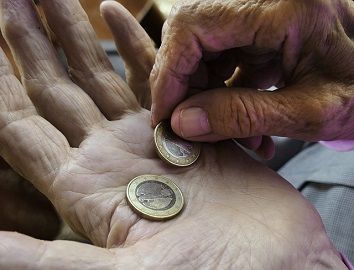 Poverty can be defined as the state in which an individual or household is not able to fulfil the minimum consumption needs. It is not always about money, but it also entails access to basic facilities such as proper hygiene, sanitation, food, shelter, drinking water, health, education, transport, whose absence as a whole, is regarded as poverty. It can be absolute poverty or relative poverty. Absolute poverty is when there is an absence of a minimum level of subsistence needed for the basic well being.
Poverty can be defined as the state in which an individual or household is not able to fulfil the minimum consumption needs. It is not always about money, but it also entails access to basic facilities such as proper hygiene, sanitation, food, shelter, drinking water, health, education, transport, whose absence as a whole, is regarded as poverty. It can be absolute poverty or relative poverty. Absolute poverty is when there is an absence of a minimum level of subsistence needed for the basic well being.
On the other hand, when poverty is measured in relative terms, such as income or consumption of other people, it is called relative poverty.
The word poverty line is often used in relation to poverty, which means an estimated minimum household income threshold, which is required to fulfil the basic necessities of life. Any person or family below this threshold is called as poor. This article will help you understand the difference between absolute and relative poverty.
Content: Absolute Poverty Vs Relative Poverty
Comparison Chart
| Basis for Comparison | Absolute Poverty | Relative Poverty |
|---|---|---|
| Meaning | Absolute poverty is a state in which a person or family is highly deprived of the basic needs making their livelihood difficult. | Relative poverty is a condition when a person or family is unable to reach the minimum average living standard, in the society. |
| Indicates poverty in relation to | Level of income needed to fulfill basic needs. | Economic status of others in society. |
| Standard | Remains consistent over time. | Changes over time. |
| Measure | Measured using poverty line | Measured using the Gini Coefficient and Lorenz Curve |
| Eradication | Not possible | Possible |
| Found in | Developing countries | Developed countries |
Definition of Absolute Poverty
Absolute poverty can be defined with the help of basic poverty line. When the income of the household is below the poverty line, then the person or family is regarded as poor. It indicates a failure in meeting the basic necessities of life (i.e. food, water, clothing and shelter) and access to the amenities like sanitation, education, medical care, information, etc., which is necessary for an individual’s physical and social well being.
In absolute poverty, we compare the income of the household, with the standard minimum income of the household. This standard minimum income threshold is different in different countries and is based on the overall economic condition. And so it helps in ascertaining the poverty level in different countries, as well as at different points in time.
Definition of Relative Poverty
Relative Poverty refers to the state in which a person lacks the least amount of income required to maintain the normal standard of living, in the society to which they belong. The ones who are not able to maintain the accepted standard of living in society, then they are considered impoverished, as they are relatively poor than the other members of society.
The word ‘relative’ means ‘in comparison to’, so here we define poverty concerning the overall distribution of income or consumption of a person, family, or nation in comparison to the other person, family or nation.
The increase in the wealth of the society results in the increase in income of its members and resources they can afford, which changes the society’s standard of living and so relative poverty changes with time.
Key Differences Between Absolute and Relative Poverty
The difference between absolute and relative poverty can be drawn clearly on the below-given grounds:
- Absolute poverty is one in which the income of the family or household is below the defined level, and so they cannot afford basic subsistence. On the other hand, relative poverty refers to the person’s way of life, which is comparatively below than the minimum acceptable standard of living in the society or region.
- Absolute poverty represents poverty with respect to the minimum level of income needed to meet the basic needs. Conversely, relative poverty indicates the economic status of a person in comparison to others in society.
- Absolute poverty remains consistent over time. As against, relative poverty, changes over time, with the increase in income and standard of living.
- Absolute poverty can be measured with the help of the poverty line. In contrast, relative poverty can be measured through the Gini Coefficient and Lorenz Curve.
- Eradication of relative poverty is possible, but it is not in the case of absolute poverty.
- Absolute poverty is a common issue in developing countries. As opposed to relative poverty, is mainly found in a developed country.
Conclusion
In absolute poverty, people are considered as poor when they fall below the poverty line, whereas in relative poverty people who fall below the existing standard of living in society. So, absolute poverty describes the people who are deprived of the basic necessities of life, whereas, relative poverty, measures the difference in resources and inequality of income, in comparison to others.






Ali Muse Sheikh says
Dearest: I would like to get some information about this field of economics because I am very interested to know this